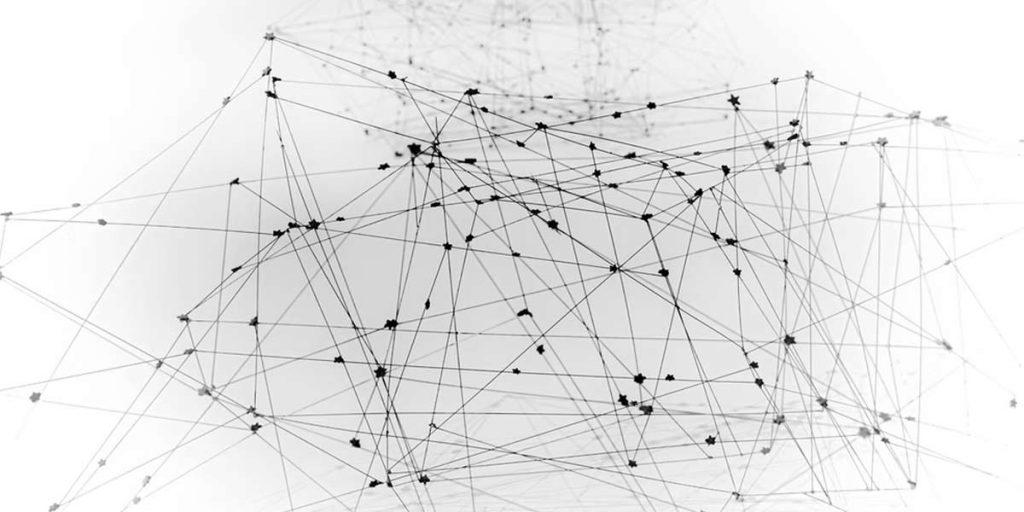Are Graph Databases the future? Structured and unstructured data coming from multiple sources can have immense value if you can find the relationships within it, Graph DBs consider the relationships between data as first-class citizens.
Inter-connected data are the future, and probably the easiest way to model interconnected data is using a Graph Database.
In this tutorial will see two different ways to model and query data using native graph database technology – TerminusDB and Neo4j.
Now let’s see how TerminusDB handles tasks compared to Neo4j in practice.
What is a Graph Database
Graph DB’s are databases that use graph structures to organize data: nodes, edges (relationship), and properties to represent and store data. The relationships allow data in the store to be linked together.
Neo4J Graph DB
- Node
- Label (:Person)
- Relationship :KNOWS
- Property {name}
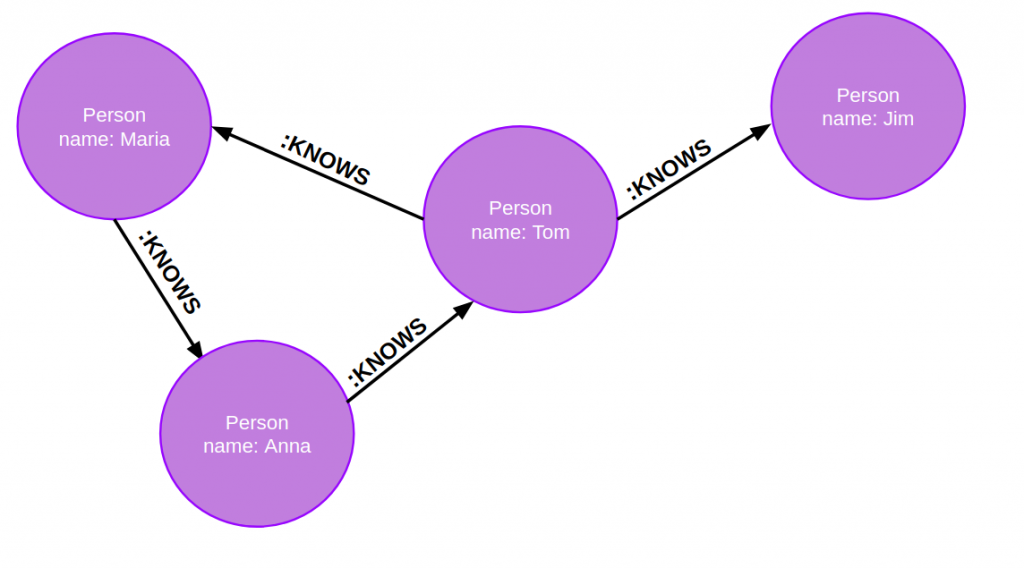
In Neo4j the main components of the property graph model are nodes and relationships, in our example, Maria, Anna, Tom and Jim are our nodes and KNOWS is our relationship between nodes.
Nodes and Relationships can have properties, properties are name-value pairs that provide additional details for nodes and relationships. You can group similar nodes together by assigning a node label (:Person). A node can have zero to many labels.
TerminusDB Graph DB
- OrdinaryClass
- DocumentClass (doc:Person)
- ObjectProperty (knows:doc:Person)
- DatatypeProperty (name:String)
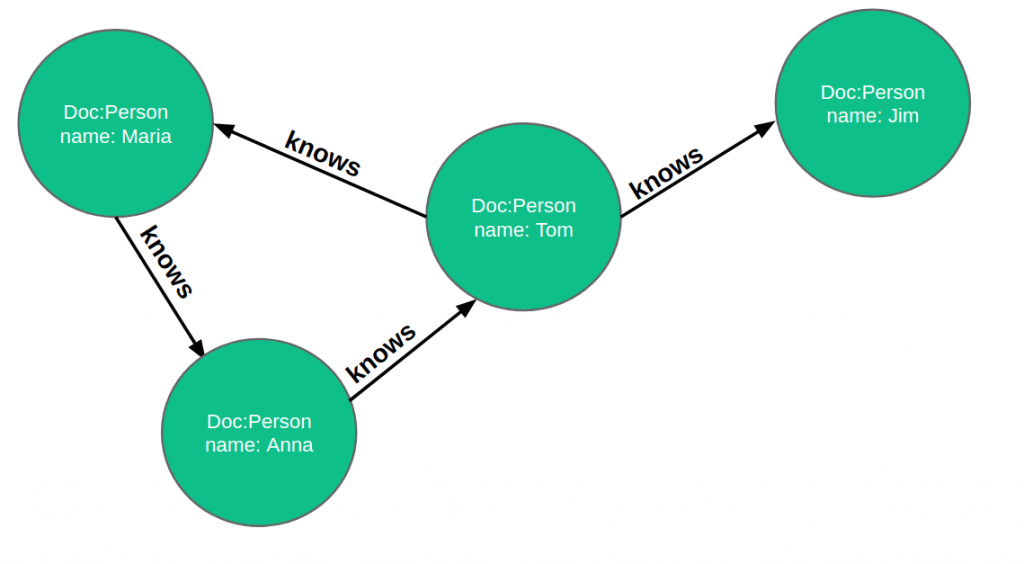
In TerminusDB everything is an object of a Class – objects can have properties and some of these properties may link to other objects. Document Classes are top-level classes, which allow the graph to be serialized into documents. Our example Maria, Anna, Tom, and Jim are our Document Objects. The knows property is an ObjectProperty with range being the Person document.
Classes can be subclasses of other classes, which means that they inherit all the parent’s properties (much like inheritance in object-oriented programming). Multiple inheritance is supported.
The type of data that the property points to can either be a simple datatype literal (e.g. an integer or string) (DatatypeProperty) or it can be a class (ObjectProperty).
Query language
Neo4j uses Cypher to store and retrieve data from the graph database. Cypher is a graph query language and the best way to interact with Neo4j.
TerminusDB uses WOQL (Web Object Query Language) which allows queries to be written in either javascript, python or as JSON-LD documents. All these examples are written using woql.js a javascript layer that allows queries to be written in simple javascript.
Schema
A schema in Neo4j refers to indexes and constraints that can be applied to nodes. Neo4j is often described as schema optional, meaning that it is not necessary to create indexes and constraints. Index and Constraint can be added at any time.
In our example we create the constraint person_unique, it specifies that the properties name and born have to exist on all nodes with label Person and the combination of the property values is unique.
CREATE CONSTRAINT person_unique
ON (n:Person) ASSERT (n.name, n.born) IS NODE KEY
TerminusDB is schema optional, but to take advantage of schema checking, it is better to create a schema before inserting data. TerminusDB lets you change your schema at any time. TerminusDB is a graph database that stores data like Git. TerminusDB allows for the whole suite of revision control features: branch, merge, squash, rollback, blame, and time-travel.
WOQL.doctype("Person")
.label("Person Name")
.description("A Person Document")
.property("name", "string").label("Name").cardinality(1)
.property("date_of_birth", "date").label("Date Of Birth").cardinality(1)
.property("knows", "Person").label("Knows")
Using the WOQL.js api, we create the Person Document class. This object has 3 properties, with three different types. The data type range in knows property (ObjectProperty) is the Person document class. The cardinality 1 for name and date_of_birth specifies that both property values have a single value.
Insert Data
Here is an graph db example of Cypher syntax for inserting data
We add 4 nodes of type (label) Person and relationships KNOWS between the nodes.
CREATE (maria:Person { name:"Maria",born:date('1978-12-03')})
CREATE (anna:Person { name:"Anna",born:date('1974-02-10')})
CREATE (tom:Person { name:"Tom",born:date('1975-06-23')})
CREATE (jim:Person { name:"Jim",born:date('1974-07-20')})
MERGE (maria)-[r:KNOWS { label: maria.name + ' knows ' + anna.name }]->(anna)
MERGE (anna)-[r01:KNOWS { label: anna.name + ' knows ' + tom.name }]->(tom)
MERGE (tom)-[r02:KNOWS { label: tom.name + ' knows ' + maria.name }]->(maria)
MERGE (tom)-[r03:KNOWS { label: tom.name + ' knows ' + jim.name }]->(jim)
RETURN maria.name, anna.name, tom.name, jim.name
Let’s see how we add documents and relationships with TerminusDB – queries are accessible in a very easy way with JavaScript using the woql.js layer.
We create Person documents and we link them using the “knows” property in Person document. Our relationships between documents have been created.
and(
idgen("doc:Person",["Maria","1978-12-03"],"v:Maria"),
idgen("doc:Person",["Anna","1974-02-10"],"v:Anna"),
idgen("doc:Person",["Tom","1975-06-23"],"v:Tom"),
idgen("doc:Person",["Jim","1974-07-20"],"v:Jim"),
insert("v:Maria", "Person").label("Maria")
.property("date_of_birth", literal("1978-12-03",'date'))
.property("name", "Maria")
.property("knows", "v:Anna"),
insert("v:Anna", "Person").label("Anna")
.property("date_of_birth", literal("1974-02-10",'date'))
.property("name", "Anna")
.property("knows", "v:Tom"),
insert("v:Tom", "Person").label("Tom")
.property("date_of_birth", literal("1975-06-23",'date'))
.property("name", "Tom")
.property("knows", "v:Maria"),
insert("v:Jim", "Person").label("Jim")
.property("date_of_birth", literal("1974-07-20",'date'))
.property("name", "Jim")
.property("knows", "v:Tom")
)
Add a new node type and relationship
In Neo4j we add a node with the label City, a new constraint and we connect our nodes Person and City with CITY_OF_BIRTH relationship
CREATE(dublin:City { name:"Dublin"})
CREATE CONSTRAINT city_name ON (city:City) ASSERT city.name IS UNIQUE
MATCH (a:Person),(b:City)
WHERE b.name = 'Dublin'
MERGE (a)-[r:CITY_OF_BIRTH { label: a.name + ' born in ' + b.name }]->(b)
RETURN type(r), r.label
In TerminusDB we create a new Document Object City
WOQL.doctype("City").label("City Name").description("A City name")
We add a new property city_of_birth in the Document Person with range type City. Here is our relationship between Person->City
add_property("city_of_birth","City").domain("Person")
Now update the data!!
and(
idgen("doc:City",["Dublin"],"v:City_id"),
insert("v:City_id", "City").label("Dublin"),
triple('v:Person','type','scm:Person'),
add_triple("v:Person","city_of_birth","v:City_id")
)
Creating hierarchies
In our graph we now add another type of Person called Doctor, this entity has all the Person properties plus it is connected to the other nodes by the patient relationship
In Neo4j we can add multi labels to a node so our node is Person and Doctor at the same time.
create (freud:Person:Doctor {name:'Freud', born:'1976-08-25'})
MATCH (a:Person),(b:Doctor)
WHERE a.name = 'Maria' AND b.name="Freud"
MERGE (a)-[r:IS_PATIENT_OF { label: a.name + ' is patient of ' + b.name }]->(b)
RETURN type(r), r.label
MATCH (a:Person),(b:Doctor)
WHERE a.name = 'Tom' AND b.name="Freud"
MERGE (a)-[r:IS_PATIENT_OF { label: a.name + ' is patient of ' + b.name }]->(b)
RETURN type(r), r.label
In TerminusDB classes can be subclasses of other classes, so let’s add a subclass for scm:Person called scm:Doctor.
A Doctor shares all of the properties available to a Person, but it also has a patient (ObjectProperty).
WOQL.doctype("Doctor")
.parent("Person")
.label("Doctor")
.description("A Doctor is a person with patients")
.property("patient", "Person")
WOQL.and(
idgen("doc:Doctor",["Freud","1976-08-25"],"v:Freud"),
insert("v:Freud", "Doctor").label("Freud")
.property("date_of_birth", literal("1976-08-25",'date'})
.property("name", "Freud")
.property("patient","doc:Person_Maria_1978-12-03")
.property("patient","doc:Person_Tom_1975-06-23")
)
Query the Data
Now, how we write our query to understand how the Person knows each other.
Here’s a Cypher example
MATCH (person:Person)-[:KNOWS]-(otherPerson:Person)
RETURN person.name,otherPerson.name
Let’s see the TerminusDB WOQL query using woql.js
or(triple('v:Person', 'knows', 'v:OtherPerson'),
triple('v:OtherPerson','knows','v:Person')
)
How do we get only people who know each other and are patients of doctor Freud?
Neo4j graph database example of a Cypher query –
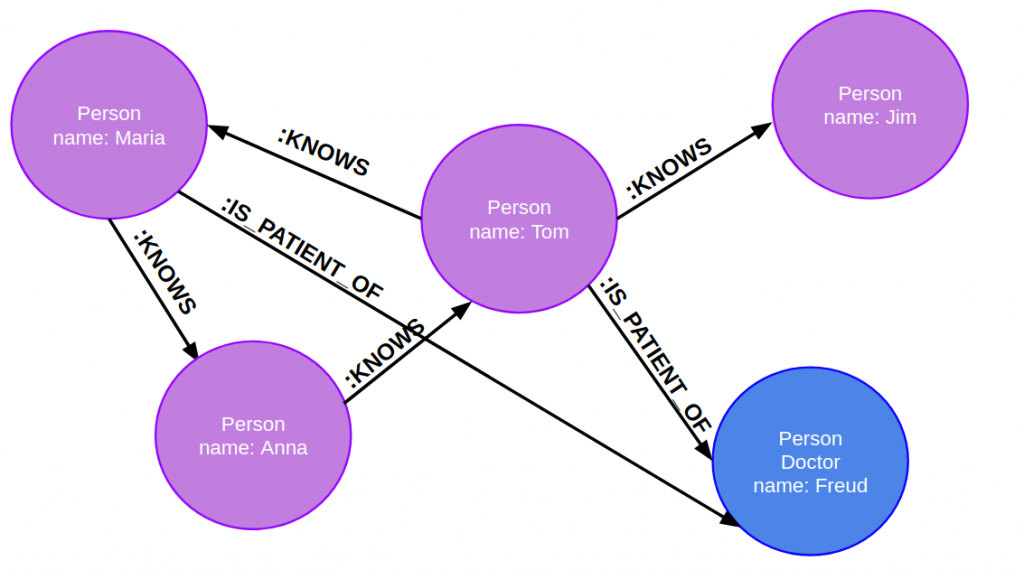
MATCH (doc:Doctor { name: 'Freud' })<-[:IS_PATIENT_OF]-(person:Person),
(doc:Doctor { name: 'Freud' })<-[:IS_PATIENT_OF]-(otherPerson:Person)
WHERE (person:Person)-[:KNOWS]-(otherPerson:Person)
RETURN person.name
TerminusDB graph database example of a query –
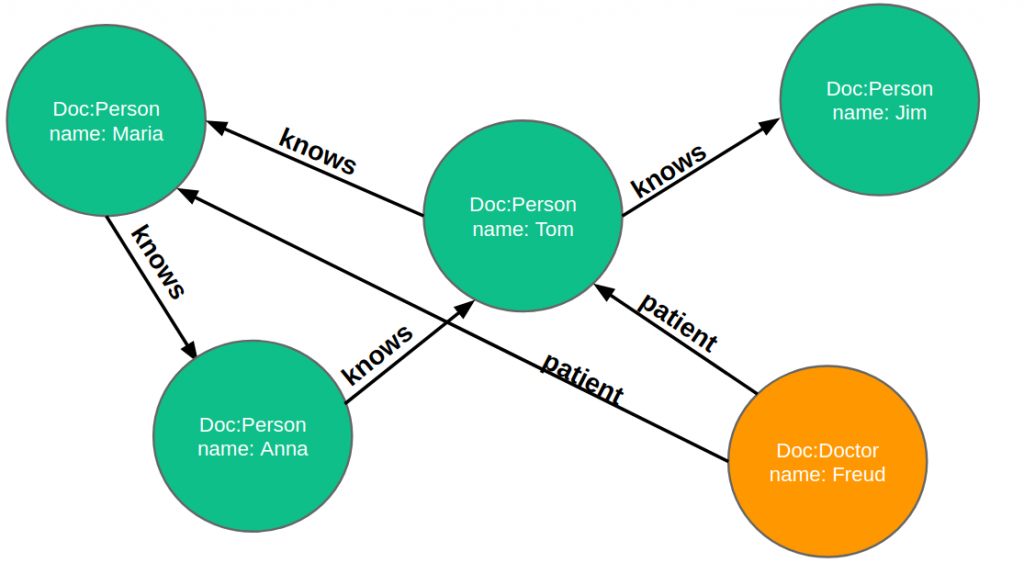
and(
triple('v:Person', 'knows', 'v:OtherPerson'),
triple("v:Doc",'patient','v:Person'),
triple("v:Doc",'patient','v:OtherPerson'),
triple("v:Doc",'name','v:Freud')
)
